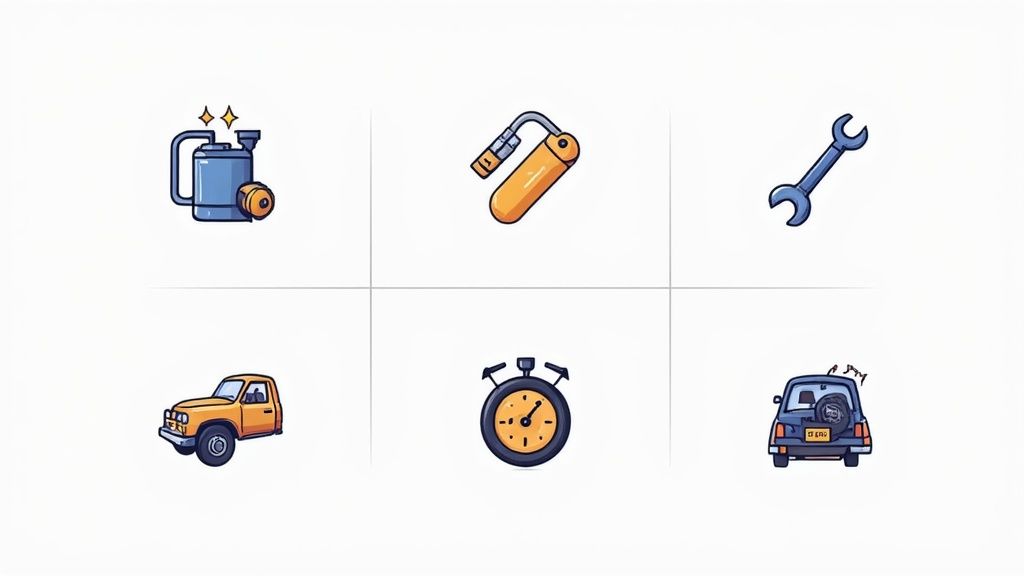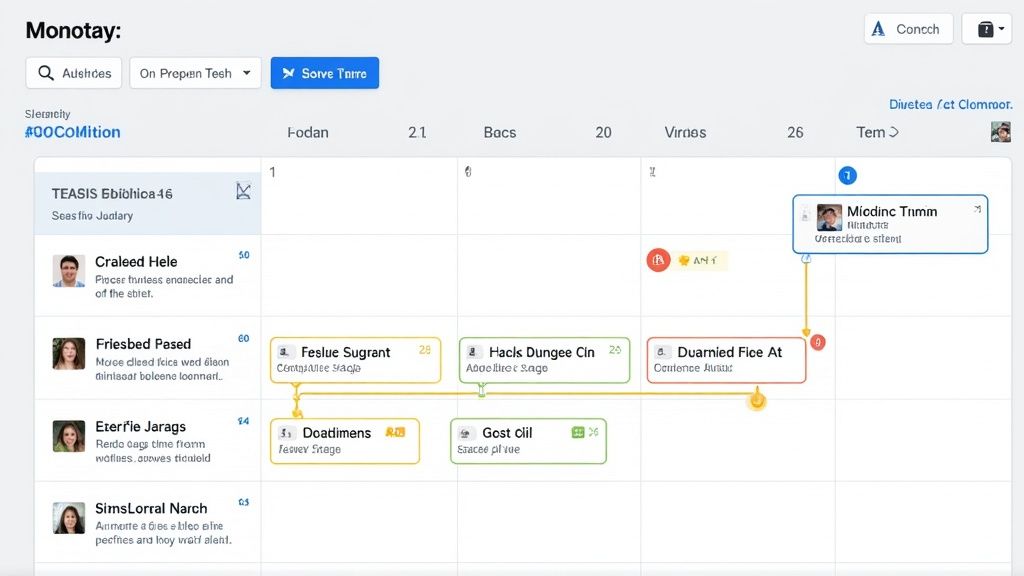
Ultimate Guide: How to Track Auto Maintenance Like a Pro
Why Tracking Auto Maintenance Transforms Vehicle Ownership
Keeping detailed records of your car’s maintenance does more than just fill up a logbook - it completely changes how you care for and experience your vehicle. Instead of rushing to fix problems after they occur, good tracking habits help you prevent issues before they start. This shift in approach helps you save money, extend your car’s life, and protect its value over time.
The Financial Perks of Proactive Maintenance
Regular maintenance tracking helps catch small problems early, preventing them from becoming expensive repairs. For instance, monitoring tire pressure and following rotation schedules prevents uneven wear that could force premature tire replacement. Similarly, keeping up with oil changes based on manufacturer recommendations protects your engine from potentially devastating damage. Studies show that consistent maintenance can reduce repair costs by up to 40% compared to reactive repairs.
Good documentation also has direct financial benefits. Using a system like LEFT LANE BRAIN, which tracks vehicle details, repair history, and maintenance patterns, makes it easy to budget for upcoming needs. This organized approach means fewer surprise expenses and more control over your car-related spending.
Boosting Resale Value With Comprehensive Records
A well-documented maintenance history makes your car significantly more valuable when it’s time to sell. Think about buying a used car - would you prefer one with scattered service receipts or one with detailed records showing regular care? Complete maintenance documentation proves your car has been properly maintained, making it more appealing to potential buyers. Cars with complete service records can command 10-15% higher resale prices than similar vehicles without documentation.
Gaining Peace of Mind and Control
Perhaps the biggest benefit is the confidence that comes from knowing exactly what’s happening with your vehicle. Having maintenance records, service dates, and repair history readily available eliminates guesswork about when services are due. This knowledge helps prevent breakdowns and gives you more control over your car ownership experience.
For example, when you track oil changes, tire rotations, and other routine services, you can plan ahead and budget accordingly. This proactive approach reduces stress and helps you make informed decisions about your vehicle’s care, rather than dealing with unexpected problems.
Time-Tested Tracking Methods That Drive Results

While digital tools offer new ways to track car maintenance, many owners find lasting value in old-school methods. Physical records provide a clear, easy-to-access history of your vehicle’s care and serve as a reliable backup when technology fails. Let’s explore why these classic tracking approaches remain essential tools for car owners.
The Simplicity and Accessibility of Logbooks
A maintenance logbook stands out as one of the most practical traditional tracking tools. This straightforward approach lets you document every service event, from routine oil changes to major repairs. You can organize entries by maintenance type, making it simple to check when you last had specific work done. Many owners appreciate having their car’s complete service history right at their fingertips.
Enhancing Organization With Modern Techniques
Simple upgrades can make traditional tracking even more effective. For example, using color-coding helps create an at-a-glance view of your maintenance history - blue for oil changes, green for tire rotations, and red for repairs. A binder system with plastic sleeves keeps receipts and documents organized alongside your logbook entries. This combination of old and new methods creates a complete maintenance record system.
Physical tracking methods continue to earn praise from car enthusiasts and experts alike. Members of the Car Talk Community often share success stories using basic notebooks or spreadsheets to log their maintenance. The simplicity of these approaches makes them particularly valuable for those who want straightforward record-keeping or need a backup for digital systems.
Foolproof Documentation: Even Without Power
One key advantage of physical records is their reliability - they work without electricity or internet access. Whether you’re dealing with a power outage or traveling through areas with poor connectivity, you can always check your maintenance history. This dependability proves especially valuable during roadside emergencies when quick access to service records could help diagnose problems. Physical logbooks ensure you never lose track of crucial maintenance information, making them an essential tool for any car owner focused on proper vehicle care.
Digital Tools for Modern Maintenance Management

Digital tools have fundamentally changed how we manage vehicle maintenance records and schedules. Apps like Simply Auto make it easy to track fuel economy, log tax-deductible mileage, and set up maintenance reminders all in one place. Popular options like aCar and Drivvo have attracted millions of users by offering features such as GPS tracking, fuel analysis, and cloud syncing - particularly useful when managing multiple vehicles.
Finding the Right Digital Solution
When selecting a maintenance tracking tool, consider what matters most for your specific needs. Here are the key factors to evaluate:
- User-Friendly Design: The interface should be simple to navigate, even if you’re not tech-savvy
- Core Features: Focus on must-haves like mileage logging, service alerts, and expense tracking
- Device Support: Make sure it works well across your phone, tablet and computer
- Price Options: Compare free versions versus paid plans with extra features - tools like Auto Service Logger offer lifetime memberships
- Data Protection: Choose platforms that properly secure your maintenance records
Making Digital Tools Part of Your Routine
Successfully adopting a new maintenance tracking system requires building consistent habits. Here’s how to make it stick:
- Enable Notifications: Use the app’s alert system to stay on top of upcoming services
- Track Everything: Record both major repairs and minor maintenance to build a complete history
- Save Documents: Store digital copies of all receipts and service records in the app
Getting More from Advanced Features
Many apps include powerful analysis tools beyond basic tracking that can provide deeper insights:
- Fuel Economy Analysis: Monitor efficiency trends and spot potential issues
- Cost Reports: Track spending patterns to find ways to save
- Performance Data: Some apps connect with diagnostic tools to catch problems early
Start with the essential features and gradually explore more advanced capabilities as you get comfortable. This steady approach helps you make the most of the technology without feeling rushed. Focus on establishing good tracking habits first, then expand into the analytics and reporting tools when you’re ready.
Transforming Data Into Performance Insights

Car maintenance tracking has evolved beyond simple oil change reminders. By carefully recording and analyzing your vehicle’s service history, you gain essential insights that help you maintain peak performance and reduce long-term costs. The key is moving from basic record-keeping to making smart, data-backed decisions about your car’s care.
Uncovering Trends and Patterns
Tracking maintenance records reveals important patterns in your vehicle’s health. For instance, if your brake pads consistently wear out faster than expected, this could point to an underlying issue with your brake system that needs attention. The Vehicle Maintenance Tracker app makes this analysis easier by letting you set service reminders, store vehicle history, and export data for review. By examining repair frequency and cost per mile, you can make better decisions about your car’s upkeep.
Predicting Maintenance Intervals
Good maintenance records help you forecast when parts will need replacement. By monitoring how long components like tires and batteries typically last on your vehicle, you can plan ahead for replacements before they fail. This proactive approach helps you avoid unexpected breakdowns and budget appropriately for upcoming maintenance needs.
Optimizing Vehicle Efficiency
Combining fuel consumption data with maintenance records provides insights into your car’s efficiency. If you notice decreased fuel economy around the time of a missed air filter change, you can identify the connection and take action. Making these connections helps you maintain optimal performance while reducing fuel costs and environmental impact.
Real-World Applications
Smart car owners use maintenance data in practical ways every day. Some analyze repair costs across different shops to find the best value, while others fine-tune their service schedules to minimize vehicle downtime. Auto service tracking platforms provide the tools needed to gather and interpret this valuable data. With features for detailed analysis and reporting, these tools help owners take control of their vehicle maintenance through informed, data-driven decisions.
Building A Proactive Maintenance Strategy That Works
Taking care of your vehicle requires more than just responding when problems arise. A well-planned maintenance approach helps prevent expensive repairs and keeps your car running smoothly for years to come. Just like regular health checkups help catch medical issues early, consistent vehicle maintenance catches small problems before they become serious headaches.
Designing a Maintenance Schedule
Start by reviewing your owner’s manual for the manufacturer’s recommended service intervals. While this provides a good baseline, consider your specific driving conditions too. Harsh weather, frequent towing, or dusty environments may require more frequent service than what’s listed in the manual. For example, if you regularly drive on dirt roads, you’ll likely need to replace air filters more often to protect your engine.
Setting Up Reminders and Tracking Service
Once you have a schedule, put a system in place to track maintenance. Digital tools like Auto Service Logger make it easy to record all service work and get reminders for upcoming maintenance. Having a detailed service history proves you’ve taken good care of the vehicle if you decide to sell it later. It also helps mechanics diagnose issues more accurately by showing the full maintenance picture.
Identifying Early Warning Signs
Stay alert for any changes in how your vehicle runs, sounds, or smells. These early signals often point to developing problems that are much cheaper to fix when caught early. For instance, squealing brakes typically mean the brake pads are wearing thin, while a burning smell could indicate transmission trouble. A small oil leak fixed promptly might cost $100, compared to thousands in engine damage if ignored.
Beyond scheduled service, tools like CarFAX Car Care and FIXD help track maintenance and provide service alerts. According to AAA research, regular preventative maintenance saves car owners significant money compared to emergency repairs. AAA members can also access free vehicle inspections and repair warranties. Learn more about smart maintenance practices on AAA’s automotive blog.
Combining Manufacturer Recommendations with Real-World Experience
The most successful maintenance plans blend factory guidelines with practical experience. As you track your car’s service history and observe its performance, you’ll learn which maintenance intervals and products work best for your specific situation. For example, you might find that synthetic oil lasts longer in your engine, or that certain brake pads hold up better to your driving style. This real-world knowledge helps you make informed decisions about caring for your vehicle.
The section “Mastering Maintenance Tracking Success” is rewritten in a more natural, human style while preserving the key information:
Mastering Maintenance Tracking Success
Creating an effective auto maintenance tracking system isn’t about finding the perfect tool - it’s about building habits that stick. By understanding common challenges and implementing proven strategies, you can develop a system that works for your specific needs. Let’s explore practical ways to track maintenance successfully, based on real experiences from car owners.
Overcoming Common Obstacles
Most people struggle with two main tracking challenges: forgetting to log maintenance and misplacing receipts. The solution is straightforward - set up regular reminders on your phone or calendar for logging tasks, and create a dedicated spot for receipts. Try using a simple scanning app to digitize receipts right after service visits, ensuring you never lose important records.
Organizing Your Records Effectively
Think of maintenance records like an organized toolbox - everything needs its proper place. For digital records, use clear naming patterns like “2023_Oil_Change” and separate folders for each vehicle. If you prefer paper records, colored folders or a binder with dividers can help keep everything sorted. The key is creating a system that lets you find information quickly when needed.
Adapting Your System Over Time
Your car’s needs change as it ages, and your tracking system should evolve too. A basic mileage log might work for a new car, but older vehicles need more detailed records of repairs and parts replacement. Check your system every few months to see if it still meets your needs. For example, if you start monitoring fuel costs, add a new tracking category for that data.
Real-World Examples: Successes and Failures
John’s success story shows the power of consistent tracking - his detailed spreadsheet of maintenance records helped him get $2,000 more when selling his car. In contrast, Sarah relied on memory alone and struggled to diagnose issues when problems arose, leading to unnecessary repair costs and wasted time at the mechanic.
Building Long-Term Habits for Success
The secret to maintenance tracking is making it routine, like checking your mirrors before driving. Record every service, even minor ones - this helps spot patterns early. For instance, noting tire pressure regularly could help identify a slow leak before it leaves you stranded.
Think of maintenance tracking as a health record for your car. Just as regular checkups help prevent major health issues, consistent maintenance records help prevent costly repairs. By applying these practical strategies and learning from others’ experiences, you can build a reliable system that protects your vehicle investment.
Ready to take control of your maintenance records? Auto Service Logger provides a lifetime membership with custom reporting tools and secure storage - everything you need to track your vehicle’s maintenance effectively.